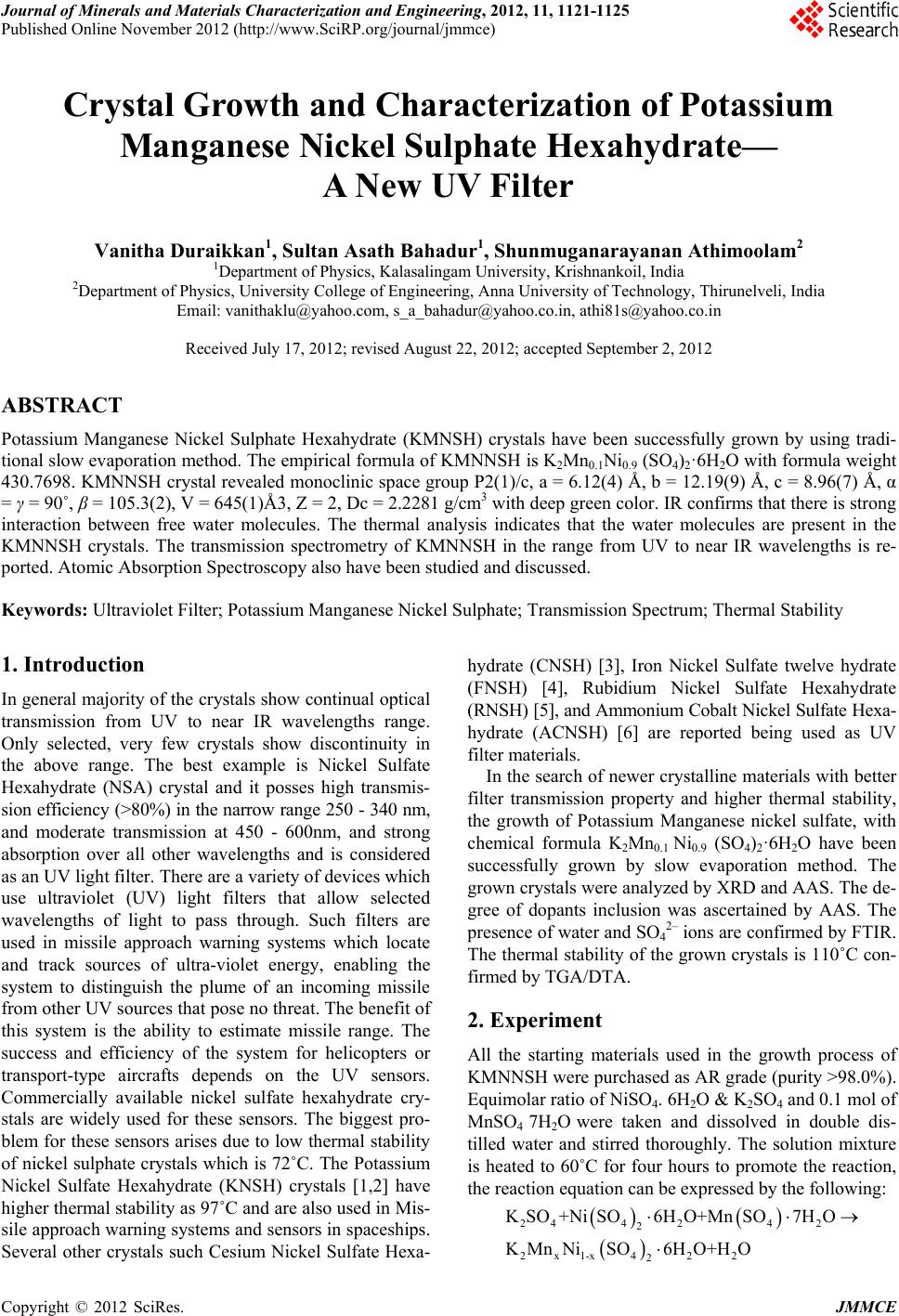
Journal of Minerals and Materials Characterization and Engineering, 2012, 11, 1121-1125
Published Online November 2012 (http://www.SciRP.org/journal/jmmce)
Crystal Growth and Characterization of Potassium
Manganese Nickel Sulphate Hexahydrate—
A New UV Filter
Vanitha Duraikkan1, Sultan Asath Bahadur1, Shunmuganarayanan Athimoolam2
1Department of Physics, Kalasalingam University, Krishnankoil, India
2Department of Physics, University College of Engineering, Anna University of Technology, Thirunelveli, India
Email: vanithaklu@yahoo.com, s_a_bahadur@yahoo.co.in, athi81s@yahoo.co.in
Received July 17, 2012; revised August 22, 2012; accepted September 2, 2012
ABSTRACT
Potassium Manganese Nickel Sulphate Hexahydrate (KMNSH) crystals have been successfully grown by using tradi-
tional slow evaporation method. The empirical formula of KMNNSH is K2Mn0.1Ni0.9 (SO4)2·6H2O with formula weight
430.7698. KMNNSH crystal revealed monoclinic space group P2(1)/c, a = 6.12(4) Å, b = 12.19(9) Å, c = 8.96(7) Å, α
= γ = 90˚, β = 105.3(2), V = 645(1)Å3, Z = 2, Dc = 2.2281 g/cm3 with deep green color. IR confirms that there is strong
interaction between free water molecules. The thermal analysis indicates that the water molecules are present in the
KMNNSH crystals. The transmission spectrometry of KMNNSH in the range from UV to near IR wavelengths is re-
ported. Atomic Absorption Spectroscopy also have been studied and discussed.
Keywords: Ultraviolet Filter; Potassium Manganese Nickel Sulphate; Transmission Spectrum; Thermal Stability
1. Introduction
In general majority of the crystals show continual optical
transmission from UV to near IR wavelengths range.
Only selected, very few crystals show discontinuity in
the above range. The best example is Nickel Sulfate
Hexahydrate (NSA) crystal and it posses high transmis-
sion efficiency (>80%) in the narrow range 250 - 340 nm,
and moderate transmission at 450 - 600nm, and strong
absorption over all other wavelengths and is considered
as an UV light filter. There are a variety of devices which
use ultraviolet (UV) light filters that allow selected
wavelengths of light to pass through. Such filters are
used in missile approach warning systems which locate
and track sources of ultra-violet energy, enabling the
system to distinguish the plume of an incoming missile
from other UV sources that pose no threat. The benefit of
this system is the ability to estimate missile range. The
success and efficiency of the system for helicopters or
transport-type aircrafts depends on the UV sensors.
Commercially available nickel sulfate hexahydrate cry-
stals are widely used for these sensors. The biggest pro-
blem for these sensors arises due to low thermal stability
of nickel sulphate crystals which is 72˚C. The Potassium
Nickel Sulfate Hexahydrate (KNSH) crystals [1,2] have
higher thermal stability as 97˚C and are also used in Mis-
sile approach warning systems and sensors in spaceships.
Several other crystals such Cesium Nickel Sulfate Hexa-
hydrate (CNSH) [3], Iron Nickel Sulfate twelve hydrate
(FNSH) [4], Rubidium Nickel Sulfate Hexahydrate
(RNSH) [5], and Ammonium Cobalt Nickel Sulfate Hexa-
hydrate (ACNSH) [6] are reported being used as UV
filter materials.
In the search of newer crystalline materials with better
filter transmission property and higher thermal stability,
the growth of Potassium Manganese nickel sulfate, with
chemical formula K2Mn0.1 Ni0.9 (SO4)2·6H2O have been
successfully grown by slow evaporation method. The
grown crystals were analyzed by XRD and AAS. The de-
gree of dopants inclusion was ascertained by AAS. The
presence of water and SO42– ions are confirmed by FTIR.
The thermal stability of the grown crystals is 110˚C con-
firmed by TGA/DTA.
2. Experiment
All the starting materials used in the growth process of
KMNNSH were purchased as AR grade (purity >98.0%).
Equimolar ratio of NiSO4. 6H2O & K2SO4 and 0.1 mol of
MnSO4 7H2O were taken and dissolved in double dis-
tilled water and stirred thoroughly. The solution mixture
is heated to 60˚C for four hours to promote the reaction,
the reaction equation can be expressed by the following:
24424 2
2
2x1-x 422
2
K SO+NiSO6H O+MnSO7H O
KMnNi SO6HO+HO
Copyright © 2012 SciRes. JMMCE